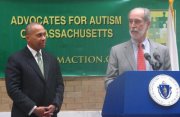Current Research
Implications for the Asperger Community
A Conference Co-Sponsored by Asperger’s Association of New England (AANE), Northeastern University, and YouthCare
Held at Northeastern University on March 16, 2012
One Person’s Observations and Reactions
©2012 Michael Forbes Wilcox
This post is a lightly-edited version of an article that appeared in Issue 10 of the AANE Journal: Spring 2012
NB: the writer has no formal training in neurology, psychology, or any other -ologies that relate to autism. These musings come from someone (with a background in economics, finance, and investments) who self-diagnosed Asperger Syndrome in 2006, at 60 years of age.
Surprising Concordance
I was struck by a couple of common themes that ran through all six of the research presentations given during the day.
-
Science has learned many things about autism in recent years, and these findings often run contrary to the received wisdom. Yet, several important research findings, such as the ones presented at this conference, have not made their way into common knowledge.
-
New scientific understanding of autism is growing by leaps and bounds, which gives us great optimism that we will rapidly gain new appreciation of just what it is that is different about this wonderfully complex neurological state. Still, the more we learn, the more we realize how much we do not understand.
Major Findings
Here are a few points that I distilled out of the day’s proceedings. There are many common misconceptions about autism; one might even call them autism myths. The latest scientific research either finds no evidence to support these beliefs or, in some cases, has proven them to be quite contrary to the evidence. Here are some of the main lessons I took away from the conference:
-
Autism is not a “spectrum” condition. There is a clear dichotomy between being autistic and non-autistic (neurotypical). In fact, autism itself is a word that describes a variety of heterogeneous neurological differences. It might be more accurate to say there are many different kinds of autism. Perhaps a better metaphor might be the “autism constellation.”
-
There is no correspondence between autism and intelligence. The terms “high-functioning” and “low-functioning” have been used to describe autistic people, based entirely or mostly on IQ level. These terms are not at all helpful, since they do not describe pragmatic functional ability.
-
Similarly, commonly used “severity” labels are neither accurate nor useful. There is neither a “mild” nor a “severe” form of autism. These terms may simply describe the difficulty of diagnosing or recognizing any given person as autistic.
-
Autistic people have a very different way of thinking about the world. That different way is just that; a difference, not a deficiency. Autistic brains simply may have a different “default” mode from neurotypical brains. We may prefer to focus on details, for example, but that does not mean we cannot see the big picture.
Brief Synopses of Presentations
There were six presenters; here is a brief look at their topics and a couple of observations about each one. This is not intended to cover the full gamut of each hour-long presentation.
-
Pharmacotherapy: There are medications that can be effective in addressing some of
the negative qualities associated with autism, including anxiety, irritability, and hyperactivity. There are no drugs, however, that can treat the core symptoms of autism, which have to do with social interaction and communication. -
Multimodal Neuroimaging: Insights gained from combining different brain-imaging techniques tell neurologists that, from a neurological point of view, autism overlaps with bipolar and schizophrenia. It is also evident that what we call autism is quite heterogeneous. That is to say, there are different types of autism, and it is not a quality that one can have more or less of (autism does not exist along a continuum, or a spectrum). Cognitive control is a key subject under investigation, and one thing has become clear: behaviors that appear the same to a casual observer may look very different neurologically. This is worrisome since autism is diagnosed primarily by observing behavior.
-
Social Engagement at School: On-site observations have called into question the value of the one-on-one aide model, at least as it is currently implemented. Also, there seems to be no empirical support for the notion that autistic children are, on average, more socially isolated than neurotypical kids. One underutilized technique for addressing socialization challenges is to engage children in suggesting solutions, instead of having teaching being guided entirely by adults. The artificial environment in which most social thinking training is done may make it less relevant than it could be.
-
Different Preferences for Attention: At least a couple of the stereotypes that have grown up around autism seem to have no scientific support. Studies designed to measure central coherence (seeing the big picture) and “sticky attention” (the relative inability to shift focus) have revealed no essential difference between autistic and neurotypical subjects. What is clear is that autistic people have different preferences; and may prefer, for example, to dwell on detail. That doesn’t mean they can’t see the big picture; it’s just not as interesting.
-
Adaptive Behavior Deficits: It used to be thought that 70% to 80% of autistic people also suffered from intellectual impairment. Recent studies show the number to be the other way around. (As an aside, I’m not aware of any connection between autism and intelligence, so I wonder why the percentage of people who are categorized as intellectually impaired would be any different – 5% – from the general population. One caveat here is that there could be developmental delays associated with autism so that age-adjusted testing could be skewed.) The concept of “high-functioning” as it relates to autism is generally only related to IQ, and so is not really addressing the ability to function in a pragmatic sense. A study of a large group of autistic people found no correlation between scores on a scale of adaptive skills (the Vineland scale) and a measure of “severity” of autism (the ADOS test). This calls into question the relevance of labels such as “mild” and “severe” since they seem to have no practical significance.
-
Physiological Features of Anxiety: As with brain imaging, measurement of physiological signs of anxiety (such as higher heart rate and perspiration) found that outward behavior is not necessarily an accurate indication of what is going on inside. This suggests that even careful observation by staff may not give an adequate (or even accurate) warning of when a person is experiencing distress. Better techniques are needed.



